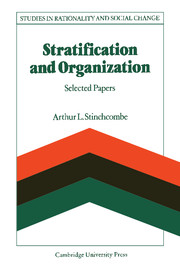Book contents
- Frontmatter
- Contents
- Acknowledgments
- 1 Rationality and social structure: an introduction
- PART I STRATIFICATION
- PART II ORGANIZATIONS
- 9 Bureaucratic and craft administration of production: a comparative study
- 10 Social structure and the founding of organizations
- 11 On social factors in administrative organization
- 12 Norms of exchange
- PART III SOCIOLOGY AS A PROFESSION
- Bibliography
- Name and place-name index
- Subject index
11 - On social factors in administrative organization
from PART II - ORGANIZATIONS
Published online by Cambridge University Press: 06 July 2010
- Frontmatter
- Contents
- Acknowledgments
- 1 Rationality and social structure: an introduction
- PART I STRATIFICATION
- PART II ORGANIZATIONS
- 9 Bureaucratic and craft administration of production: a comparative study
- 10 Social structure and the founding of organizations
- 11 On social factors in administrative organization
- 12 Norms of exchange
- PART III SOCIOLOGY AS A PROFESSION
- Bibliography
- Name and place-name index
- Subject index
Summary
The basic postulate of this presentation is that resistance to administrative innovations is mostly due to (more or less) rational anticipation that concrete interests (career prospects, risks of failure, chance for exceptional success, etc.) are endangered. Consequently what we want to do is to classify administrative innovations simultaneously by the interests they advance (generally collective interests or goals of some corporate group) and interests they damage (generally interests ‘vested in,’ i.e. protected by the normative structure embedded in, the old régime). In general the idea is that in order to advance some corporate interest in higher efficiency, one has to sacrifice the career or authority interests of some people who are advantaged by the old régime. If we can connect together sources of higher efficiency with types of damage to ‘vested interests,’ we will have the basis for a differentiated theory of resistance to administrative innovation.
The general reasons that this is a special problem are that: (1) a general way to reward administrative responsibility is by the promotions – and administrative reorganization reorganizes promotion chances; (2) a sign of one's future career chances, and a symbol that can be used in interpersonal prestige seeking, is the weight of the decisions one is responsible for – and administrative reorganization redistributes authority; (3) administration is a matter of the relations between information and decisions, but the right to take a decision is a property right, because different decisions give profits to different people – in order to reorganize information processing for decisions, therefore one often must reorganize property rights, and such reorganization often involves therefore top levels of the organization and property, rather than technical, considerations.
- Type
- Chapter
- Information
- Stratification and OrganizationSelected Papers, pp. 221 - 230Publisher: Cambridge University PressPrint publication year: 1986



